An Analysis of the Ageing Population, Trends and Social Care in the UK
VerifiedAdded on 2020/05/28
|10
|2215
|151
Report
AI Summary
This report provides a comprehensive overview of the ageing population in the United Kingdom. It begins by examining demographic patterns, trends, and societal changes, including the increasing share of older people and its implications for various sectors such as financial and labor markets. The report highlights the impact of rising life expectancy and migration on the UK's population structure. It then delves into the social care provisions available for the elderly, discussing the evolution of care services, including NHS care, sheltered housing, and financial benefits. Furthermore, the report explores the challenges related to multiculturalism and health disparities within the ageing population. The conclusion emphasizes the need for comprehensive care to address the growing needs of the elderly population and address existing disparities. The report utilizes data and research to support its findings, providing a valuable resource for understanding the complexities of an ageing society.
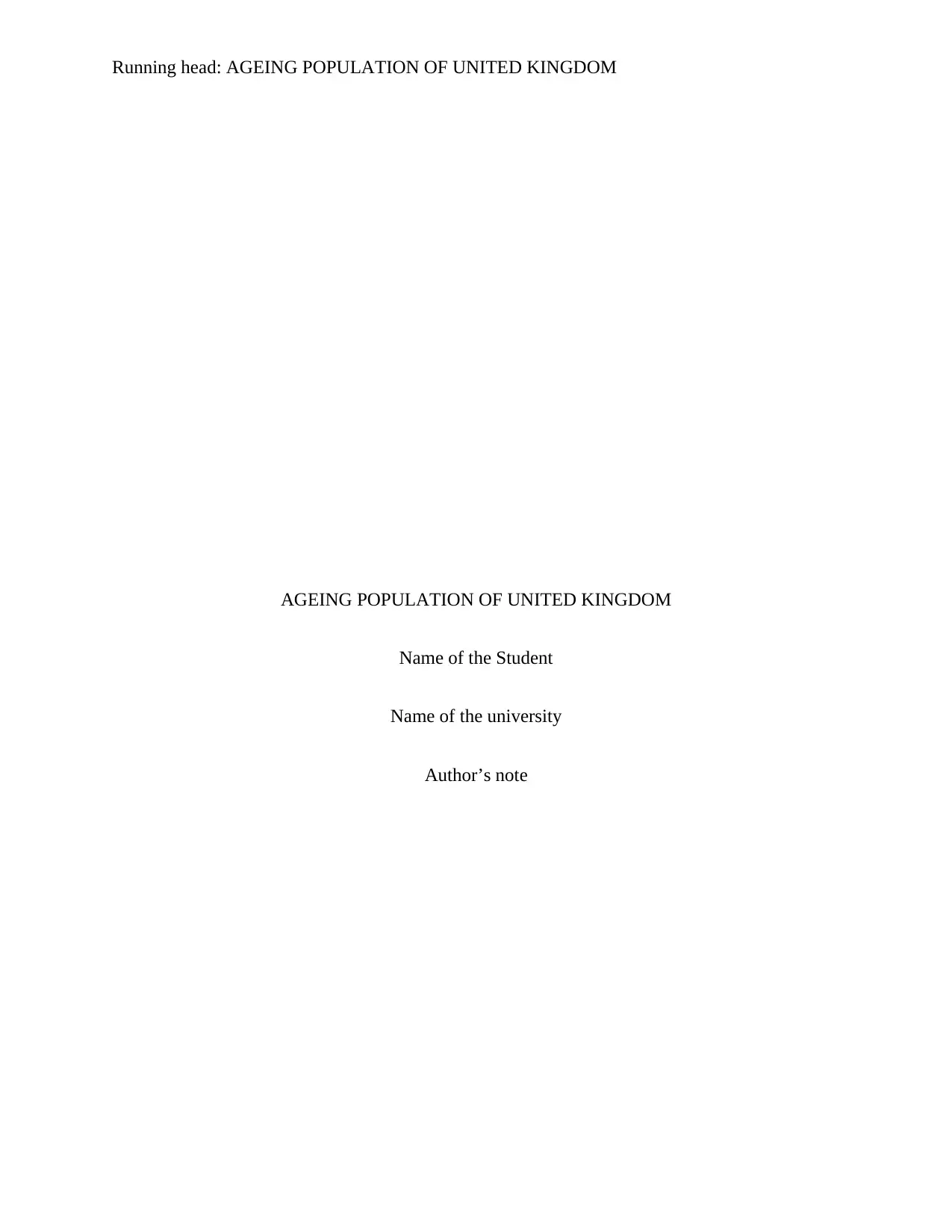
Running head: AGEING POPULATION OF UNITED KINGDOM
AGEING POPULATION OF UNITED KINGDOM
Name of the Student
Name of the university
Author’s note
AGEING POPULATION OF UNITED KINGDOM
Name of the Student
Name of the university
Author’s note
Secure Best Marks with AI Grader
Need help grading? Try our AI Grader for instant feedback on your assignments.
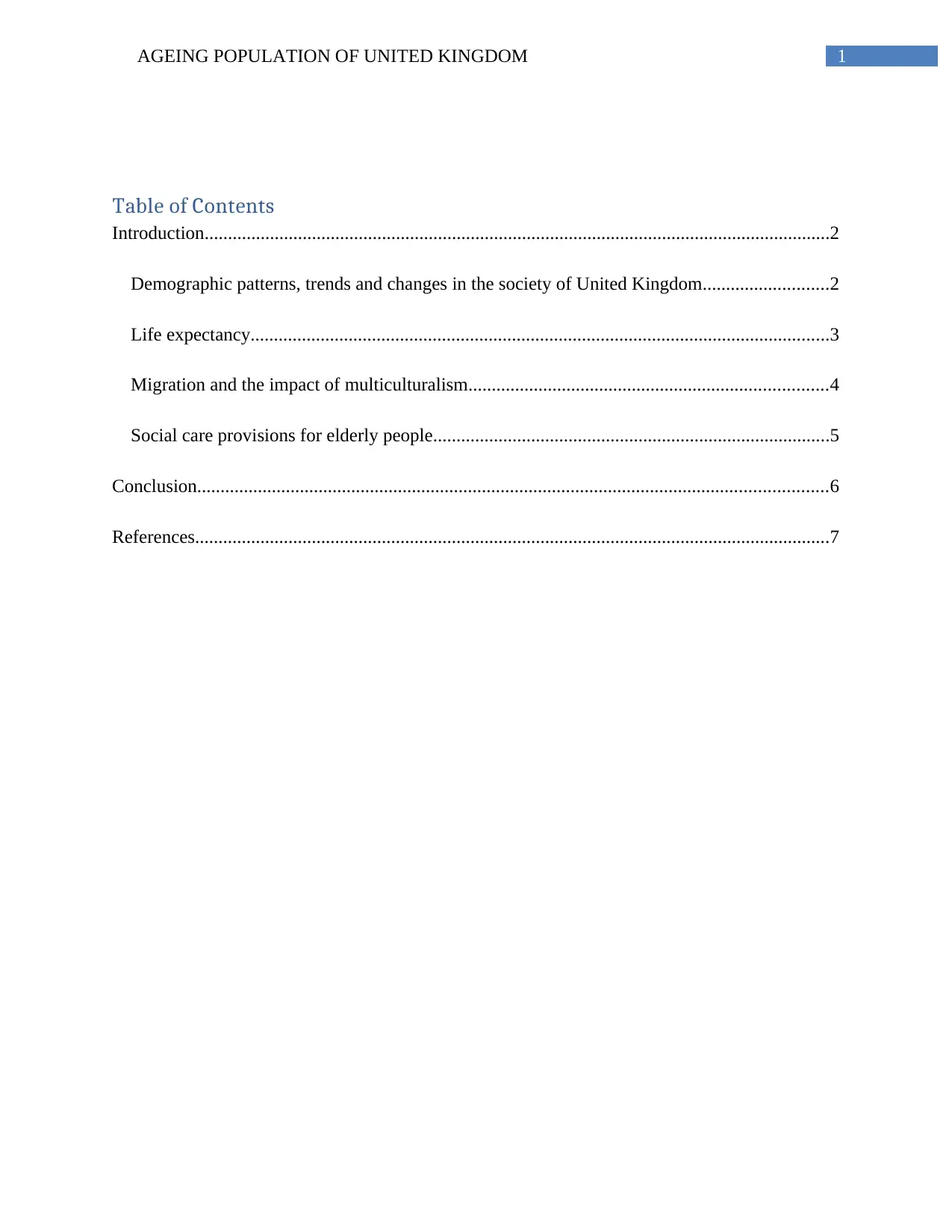
1AGEING POPULATION OF UNITED KINGDOM
Table of Contents
Introduction......................................................................................................................................2
Demographic patterns, trends and changes in the society of United Kingdom...........................2
Life expectancy............................................................................................................................3
Migration and the impact of multiculturalism.............................................................................4
Social care provisions for elderly people.....................................................................................5
Conclusion.......................................................................................................................................6
References........................................................................................................................................7
Table of Contents
Introduction......................................................................................................................................2
Demographic patterns, trends and changes in the society of United Kingdom...........................2
Life expectancy............................................................................................................................3
Migration and the impact of multiculturalism.............................................................................4
Social care provisions for elderly people.....................................................................................5
Conclusion.......................................................................................................................................6
References........................................................................................................................................7
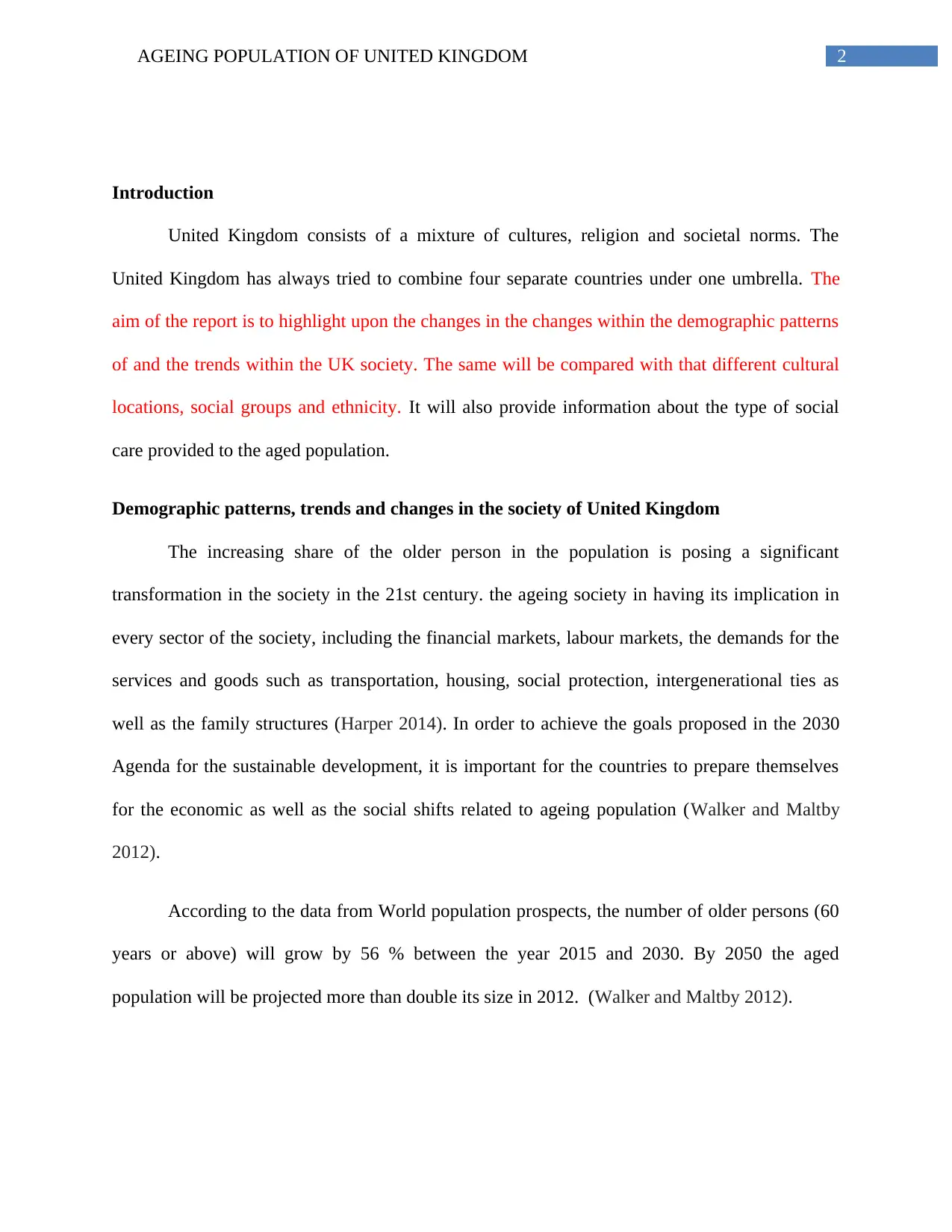
2AGEING POPULATION OF UNITED KINGDOM
Introduction
United Kingdom consists of a mixture of cultures, religion and societal norms. The
United Kingdom has always tried to combine four separate countries under one umbrella. The
aim of the report is to highlight upon the changes in the changes within the demographic patterns
of and the trends within the UK society. The same will be compared with that different cultural
locations, social groups and ethnicity. It will also provide information about the type of social
care provided to the aged population.
Demographic patterns, trends and changes in the society of United Kingdom
The increasing share of the older person in the population is posing a significant
transformation in the society in the 21st century. the ageing society in having its implication in
every sector of the society, including the financial markets, labour markets, the demands for the
services and goods such as transportation, housing, social protection, intergenerational ties as
well as the family structures (Harper 2014). In order to achieve the goals proposed in the 2030
Agenda for the sustainable development, it is important for the countries to prepare themselves
for the economic as well as the social shifts related to ageing population (Walker and Maltby
2012).
According to the data from World population prospects, the number of older persons (60
years or above) will grow by 56 % between the year 2015 and 2030. By 2050 the aged
population will be projected more than double its size in 2012. (Walker and Maltby 2012).
Introduction
United Kingdom consists of a mixture of cultures, religion and societal norms. The
United Kingdom has always tried to combine four separate countries under one umbrella. The
aim of the report is to highlight upon the changes in the changes within the demographic patterns
of and the trends within the UK society. The same will be compared with that different cultural
locations, social groups and ethnicity. It will also provide information about the type of social
care provided to the aged population.
Demographic patterns, trends and changes in the society of United Kingdom
The increasing share of the older person in the population is posing a significant
transformation in the society in the 21st century. the ageing society in having its implication in
every sector of the society, including the financial markets, labour markets, the demands for the
services and goods such as transportation, housing, social protection, intergenerational ties as
well as the family structures (Harper 2014). In order to achieve the goals proposed in the 2030
Agenda for the sustainable development, it is important for the countries to prepare themselves
for the economic as well as the social shifts related to ageing population (Walker and Maltby
2012).
According to the data from World population prospects, the number of older persons (60
years or above) will grow by 56 % between the year 2015 and 2030. By 2050 the aged
population will be projected more than double its size in 2012. (Walker and Maltby 2012).
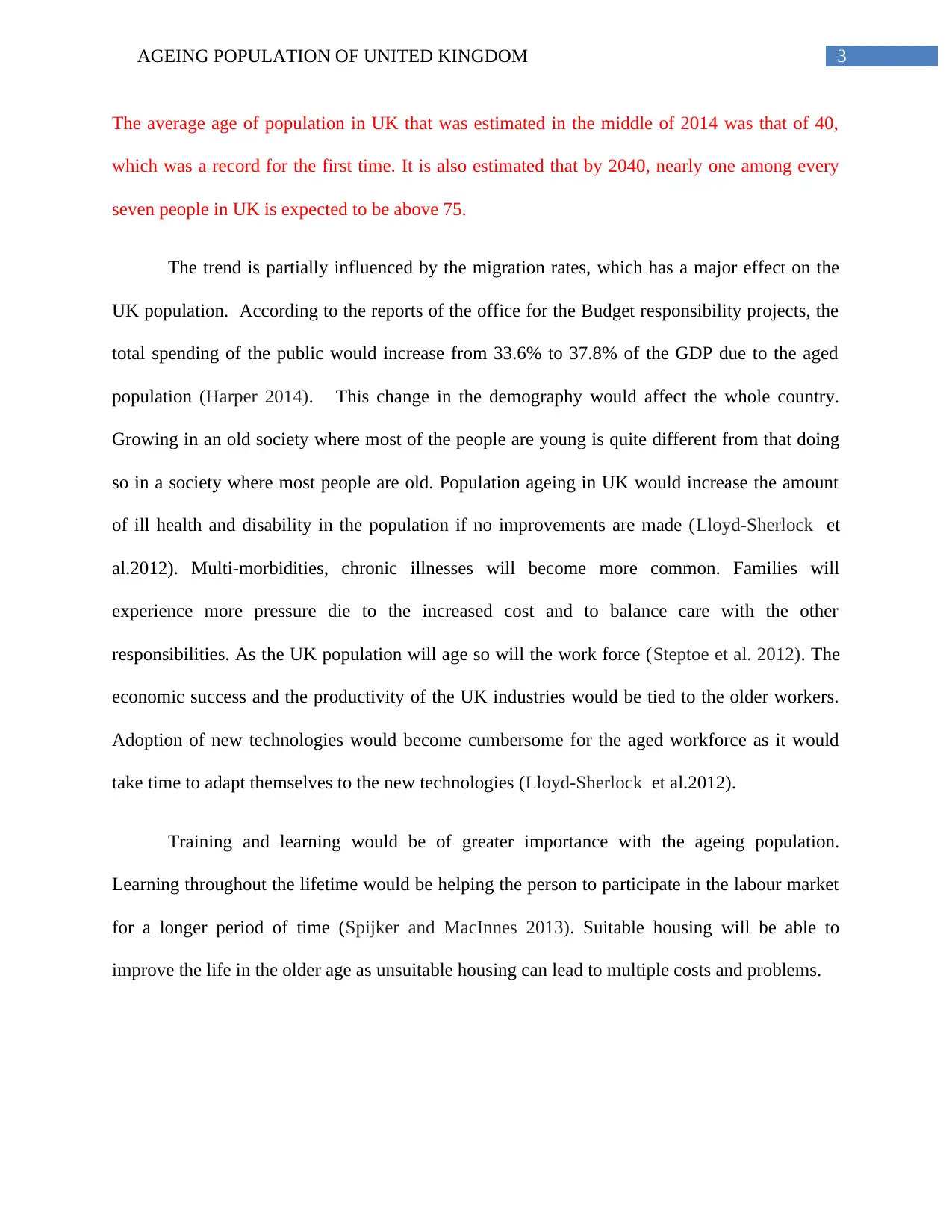
3AGEING POPULATION OF UNITED KINGDOM
The average age of population in UK that was estimated in the middle of 2014 was that of 40,
which was a record for the first time. It is also estimated that by 2040, nearly one among every
seven people in UK is expected to be above 75.
The trend is partially influenced by the migration rates, which has a major effect on the
UK population. According to the reports of the office for the Budget responsibility projects, the
total spending of the public would increase from 33.6% to 37.8% of the GDP due to the aged
population (Harper 2014). This change in the demography would affect the whole country.
Growing in an old society where most of the people are young is quite different from that doing
so in a society where most people are old. Population ageing in UK would increase the amount
of ill health and disability in the population if no improvements are made (Lloyd-Sherlock et
al.2012). Multi-morbidities, chronic illnesses will become more common. Families will
experience more pressure die to the increased cost and to balance care with the other
responsibilities. As the UK population will age so will the work force (Steptoe et al. 2012). The
economic success and the productivity of the UK industries would be tied to the older workers.
Adoption of new technologies would become cumbersome for the aged workforce as it would
take time to adapt themselves to the new technologies (Lloyd-Sherlock et al.2012).
Training and learning would be of greater importance with the ageing population.
Learning throughout the lifetime would be helping the person to participate in the labour market
for a longer period of time (Spijker and MacInnes 2013). Suitable housing will be able to
improve the life in the older age as unsuitable housing can lead to multiple costs and problems.
The average age of population in UK that was estimated in the middle of 2014 was that of 40,
which was a record for the first time. It is also estimated that by 2040, nearly one among every
seven people in UK is expected to be above 75.
The trend is partially influenced by the migration rates, which has a major effect on the
UK population. According to the reports of the office for the Budget responsibility projects, the
total spending of the public would increase from 33.6% to 37.8% of the GDP due to the aged
population (Harper 2014). This change in the demography would affect the whole country.
Growing in an old society where most of the people are young is quite different from that doing
so in a society where most people are old. Population ageing in UK would increase the amount
of ill health and disability in the population if no improvements are made (Lloyd-Sherlock et
al.2012). Multi-morbidities, chronic illnesses will become more common. Families will
experience more pressure die to the increased cost and to balance care with the other
responsibilities. As the UK population will age so will the work force (Steptoe et al. 2012). The
economic success and the productivity of the UK industries would be tied to the older workers.
Adoption of new technologies would become cumbersome for the aged workforce as it would
take time to adapt themselves to the new technologies (Lloyd-Sherlock et al.2012).
Training and learning would be of greater importance with the ageing population.
Learning throughout the lifetime would be helping the person to participate in the labour market
for a longer period of time (Spijker and MacInnes 2013). Suitable housing will be able to
improve the life in the older age as unsuitable housing can lead to multiple costs and problems.
Secure Best Marks with AI Grader
Need help grading? Try our AI Grader for instant feedback on your assignments.
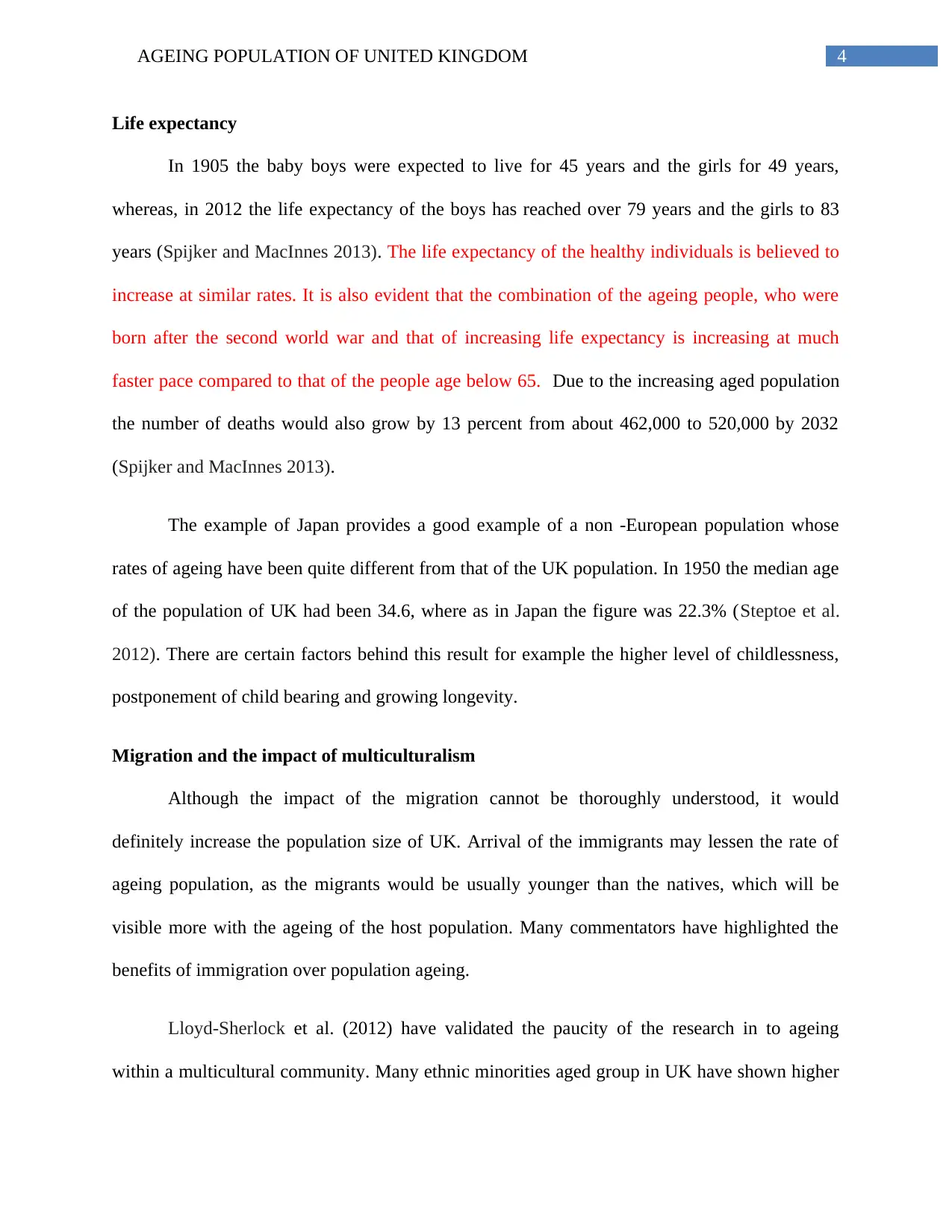
4AGEING POPULATION OF UNITED KINGDOM
Life expectancy
In 1905 the baby boys were expected to live for 45 years and the girls for 49 years,
whereas, in 2012 the life expectancy of the boys has reached over 79 years and the girls to 83
years (Spijker and MacInnes 2013). The life expectancy of the healthy individuals is believed to
increase at similar rates. It is also evident that the combination of the ageing people, who were
born after the second world war and that of increasing life expectancy is increasing at much
faster pace compared to that of the people age below 65. Due to the increasing aged population
the number of deaths would also grow by 13 percent from about 462,000 to 520,000 by 2032
(Spijker and MacInnes 2013).
The example of Japan provides a good example of a non -European population whose
rates of ageing have been quite different from that of the UK population. In 1950 the median age
of the population of UK had been 34.6, where as in Japan the figure was 22.3% (Steptoe et al.
2012). There are certain factors behind this result for example the higher level of childlessness,
postponement of child bearing and growing longevity.
Migration and the impact of multiculturalism
Although the impact of the migration cannot be thoroughly understood, it would
definitely increase the population size of UK. Arrival of the immigrants may lessen the rate of
ageing population, as the migrants would be usually younger than the natives, which will be
visible more with the ageing of the host population. Many commentators have highlighted the
benefits of immigration over population ageing.
Lloyd-Sherlock et al. (2012) have validated the paucity of the research in to ageing
within a multicultural community. Many ethnic minorities aged group in UK have shown higher
Life expectancy
In 1905 the baby boys were expected to live for 45 years and the girls for 49 years,
whereas, in 2012 the life expectancy of the boys has reached over 79 years and the girls to 83
years (Spijker and MacInnes 2013). The life expectancy of the healthy individuals is believed to
increase at similar rates. It is also evident that the combination of the ageing people, who were
born after the second world war and that of increasing life expectancy is increasing at much
faster pace compared to that of the people age below 65. Due to the increasing aged population
the number of deaths would also grow by 13 percent from about 462,000 to 520,000 by 2032
(Spijker and MacInnes 2013).
The example of Japan provides a good example of a non -European population whose
rates of ageing have been quite different from that of the UK population. In 1950 the median age
of the population of UK had been 34.6, where as in Japan the figure was 22.3% (Steptoe et al.
2012). There are certain factors behind this result for example the higher level of childlessness,
postponement of child bearing and growing longevity.
Migration and the impact of multiculturalism
Although the impact of the migration cannot be thoroughly understood, it would
definitely increase the population size of UK. Arrival of the immigrants may lessen the rate of
ageing population, as the migrants would be usually younger than the natives, which will be
visible more with the ageing of the host population. Many commentators have highlighted the
benefits of immigration over population ageing.
Lloyd-Sherlock et al. (2012) have validated the paucity of the research in to ageing
within a multicultural community. Many ethnic minorities aged group in UK have shown higher
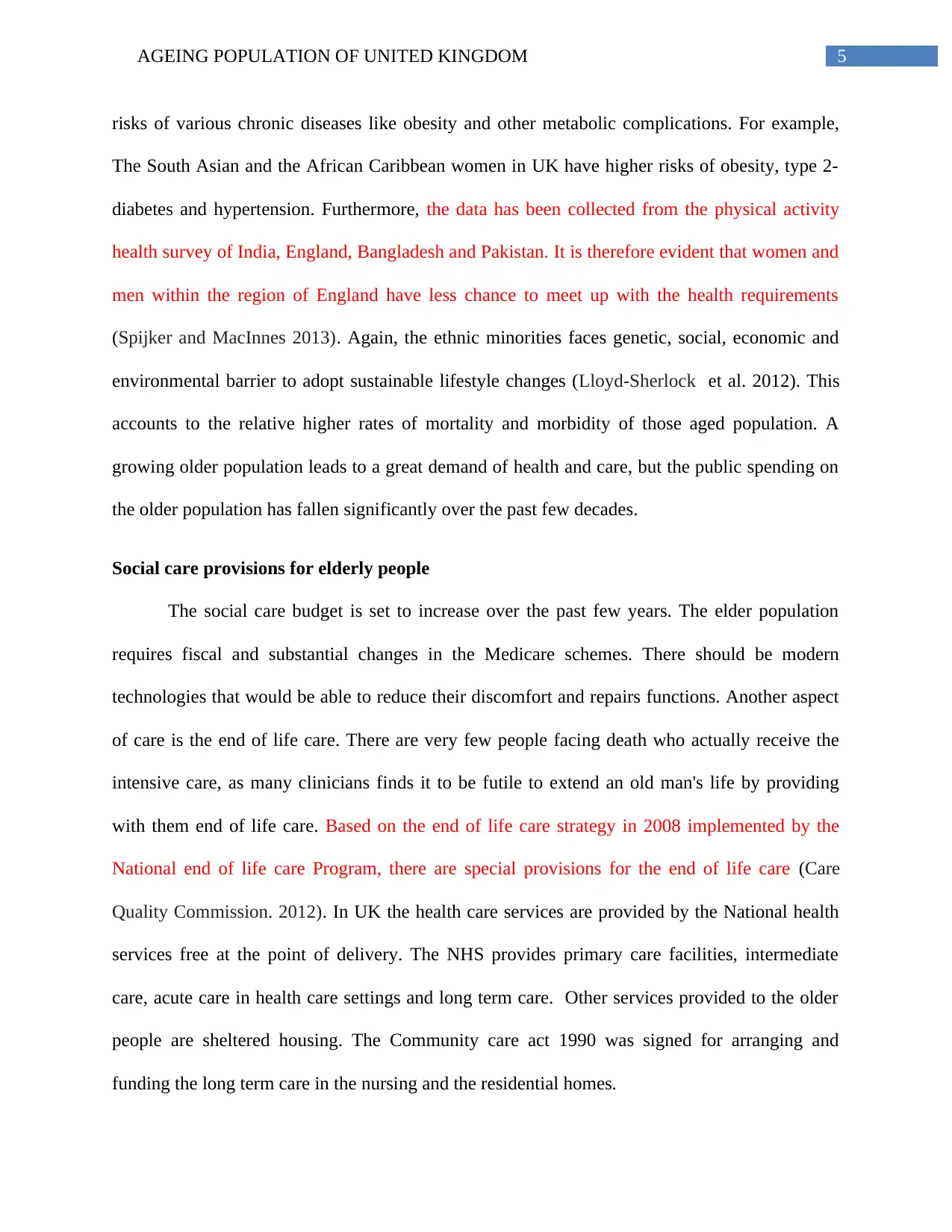
5AGEING POPULATION OF UNITED KINGDOM
risks of various chronic diseases like obesity and other metabolic complications. For example,
The South Asian and the African Caribbean women in UK have higher risks of obesity, type 2-
diabetes and hypertension. Furthermore, the data has been collected from the physical activity
health survey of India, England, Bangladesh and Pakistan. It is therefore evident that women and
men within the region of England have less chance to meet up with the health requirements
(Spijker and MacInnes 2013). Again, the ethnic minorities faces genetic, social, economic and
environmental barrier to adopt sustainable lifestyle changes (Lloyd-Sherlock et al. 2012). This
accounts to the relative higher rates of mortality and morbidity of those aged population. A
growing older population leads to a great demand of health and care, but the public spending on
the older population has fallen significantly over the past few decades.
Social care provisions for elderly people
The social care budget is set to increase over the past few years. The elder population
requires fiscal and substantial changes in the Medicare schemes. There should be modern
technologies that would be able to reduce their discomfort and repairs functions. Another aspect
of care is the end of life care. There are very few people facing death who actually receive the
intensive care, as many clinicians finds it to be futile to extend an old man's life by providing
with them end of life care. Based on the end of life care strategy in 2008 implemented by the
National end of life care Program, there are special provisions for the end of life care (Care
Quality Commission. 2012). In UK the health care services are provided by the National health
services free at the point of delivery. The NHS provides primary care facilities, intermediate
care, acute care in health care settings and long term care. Other services provided to the older
people are sheltered housing. The Community care act 1990 was signed for arranging and
funding the long term care in the nursing and the residential homes.
risks of various chronic diseases like obesity and other metabolic complications. For example,
The South Asian and the African Caribbean women in UK have higher risks of obesity, type 2-
diabetes and hypertension. Furthermore, the data has been collected from the physical activity
health survey of India, England, Bangladesh and Pakistan. It is therefore evident that women and
men within the region of England have less chance to meet up with the health requirements
(Spijker and MacInnes 2013). Again, the ethnic minorities faces genetic, social, economic and
environmental barrier to adopt sustainable lifestyle changes (Lloyd-Sherlock et al. 2012). This
accounts to the relative higher rates of mortality and morbidity of those aged population. A
growing older population leads to a great demand of health and care, but the public spending on
the older population has fallen significantly over the past few decades.
Social care provisions for elderly people
The social care budget is set to increase over the past few years. The elder population
requires fiscal and substantial changes in the Medicare schemes. There should be modern
technologies that would be able to reduce their discomfort and repairs functions. Another aspect
of care is the end of life care. There are very few people facing death who actually receive the
intensive care, as many clinicians finds it to be futile to extend an old man's life by providing
with them end of life care. Based on the end of life care strategy in 2008 implemented by the
National end of life care Program, there are special provisions for the end of life care (Care
Quality Commission. 2012). In UK the health care services are provided by the National health
services free at the point of delivery. The NHS provides primary care facilities, intermediate
care, acute care in health care settings and long term care. Other services provided to the older
people are sheltered housing. The Community care act 1990 was signed for arranging and
funding the long term care in the nursing and the residential homes.
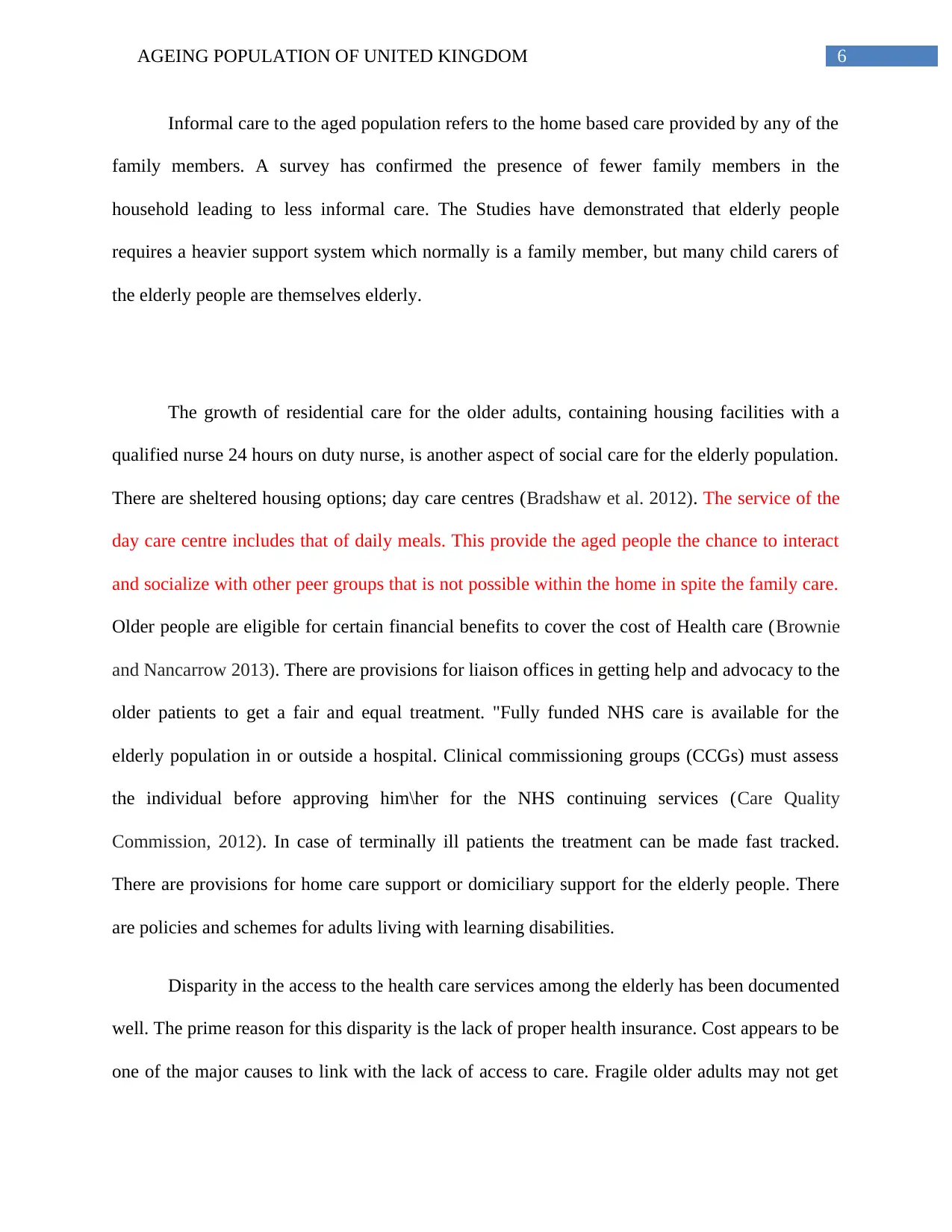
6AGEING POPULATION OF UNITED KINGDOM
Informal care to the aged population refers to the home based care provided by any of the
family members. A survey has confirmed the presence of fewer family members in the
household leading to less informal care. The Studies have demonstrated that elderly people
requires a heavier support system which normally is a family member, but many child carers of
the elderly people are themselves elderly.
The growth of residential care for the older adults, containing housing facilities with a
qualified nurse 24 hours on duty nurse, is another aspect of social care for the elderly population.
There are sheltered housing options; day care centres (Bradshaw et al. 2012). The service of the
day care centre includes that of daily meals. This provide the aged people the chance to interact
and socialize with other peer groups that is not possible within the home in spite the family care.
Older people are eligible for certain financial benefits to cover the cost of Health care (Brownie
and Nancarrow 2013). There are provisions for liaison offices in getting help and advocacy to the
older patients to get a fair and equal treatment. "Fully funded NHS care is available for the
elderly population in or outside a hospital. Clinical commissioning groups (CCGs) must assess
the individual before approving him\her for the NHS continuing services (Care Quality
Commission, 2012). In case of terminally ill patients the treatment can be made fast tracked.
There are provisions for home care support or domiciliary support for the elderly people. There
are policies and schemes for adults living with learning disabilities.
Disparity in the access to the health care services among the elderly has been documented
well. The prime reason for this disparity is the lack of proper health insurance. Cost appears to be
one of the major causes to link with the lack of access to care. Fragile older adults may not get
Informal care to the aged population refers to the home based care provided by any of the
family members. A survey has confirmed the presence of fewer family members in the
household leading to less informal care. The Studies have demonstrated that elderly people
requires a heavier support system which normally is a family member, but many child carers of
the elderly people are themselves elderly.
The growth of residential care for the older adults, containing housing facilities with a
qualified nurse 24 hours on duty nurse, is another aspect of social care for the elderly population.
There are sheltered housing options; day care centres (Bradshaw et al. 2012). The service of the
day care centre includes that of daily meals. This provide the aged people the chance to interact
and socialize with other peer groups that is not possible within the home in spite the family care.
Older people are eligible for certain financial benefits to cover the cost of Health care (Brownie
and Nancarrow 2013). There are provisions for liaison offices in getting help and advocacy to the
older patients to get a fair and equal treatment. "Fully funded NHS care is available for the
elderly population in or outside a hospital. Clinical commissioning groups (CCGs) must assess
the individual before approving him\her for the NHS continuing services (Care Quality
Commission, 2012). In case of terminally ill patients the treatment can be made fast tracked.
There are provisions for home care support or domiciliary support for the elderly people. There
are policies and schemes for adults living with learning disabilities.
Disparity in the access to the health care services among the elderly has been documented
well. The prime reason for this disparity is the lack of proper health insurance. Cost appears to be
one of the major causes to link with the lack of access to care. Fragile older adults may not get
Paraphrase This Document
Need a fresh take? Get an instant paraphrase of this document with our AI Paraphraser
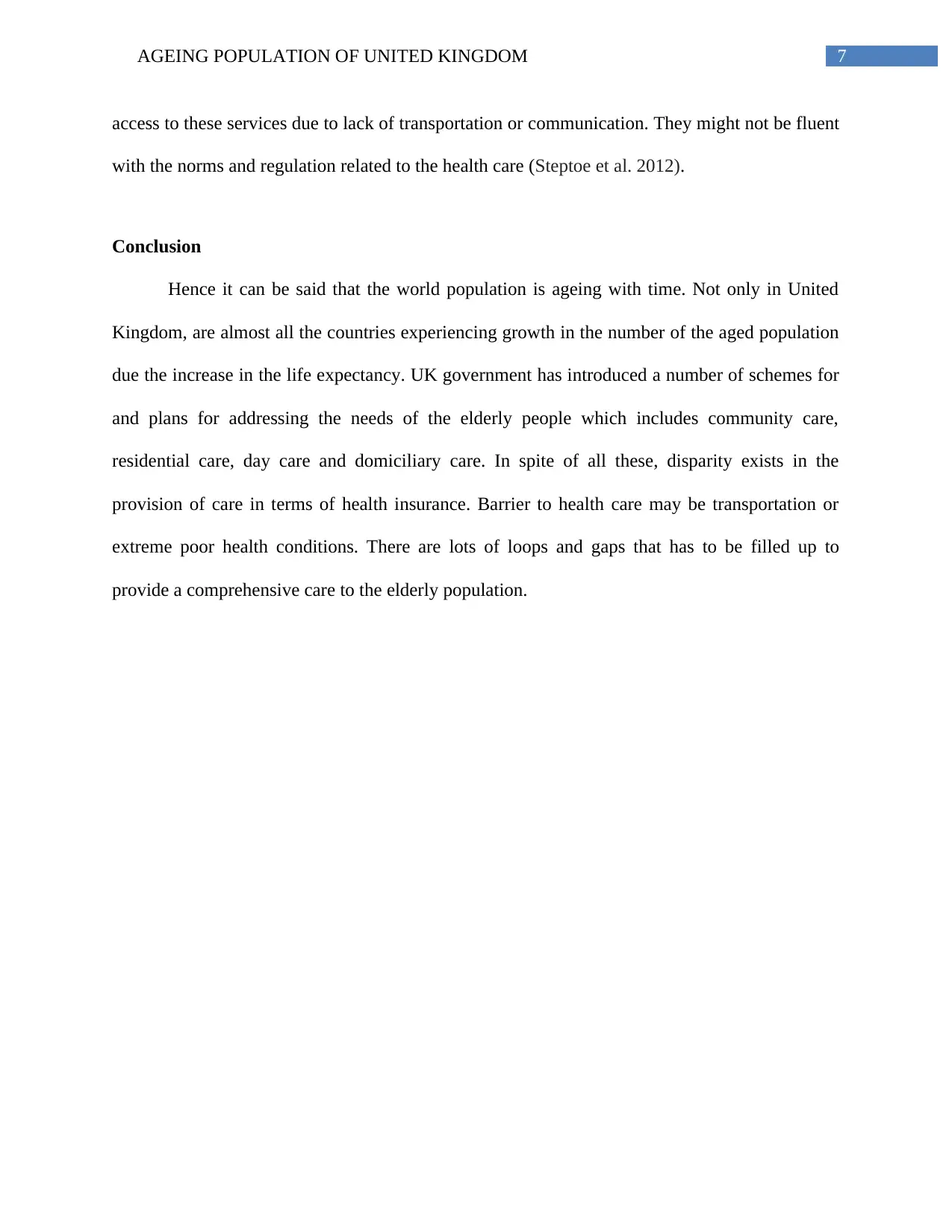
7AGEING POPULATION OF UNITED KINGDOM
access to these services due to lack of transportation or communication. They might not be fluent
with the norms and regulation related to the health care (Steptoe et al. 2012).
Conclusion
Hence it can be said that the world population is ageing with time. Not only in United
Kingdom, are almost all the countries experiencing growth in the number of the aged population
due the increase in the life expectancy. UK government has introduced a number of schemes for
and plans for addressing the needs of the elderly people which includes community care,
residential care, day care and domiciliary care. In spite of all these, disparity exists in the
provision of care in terms of health insurance. Barrier to health care may be transportation or
extreme poor health conditions. There are lots of loops and gaps that has to be filled up to
provide a comprehensive care to the elderly population.
access to these services due to lack of transportation or communication. They might not be fluent
with the norms and regulation related to the health care (Steptoe et al. 2012).
Conclusion
Hence it can be said that the world population is ageing with time. Not only in United
Kingdom, are almost all the countries experiencing growth in the number of the aged population
due the increase in the life expectancy. UK government has introduced a number of schemes for
and plans for addressing the needs of the elderly people which includes community care,
residential care, day care and domiciliary care. In spite of all these, disparity exists in the
provision of care in terms of health insurance. Barrier to health care may be transportation or
extreme poor health conditions. There are lots of loops and gaps that has to be filled up to
provide a comprehensive care to the elderly population.
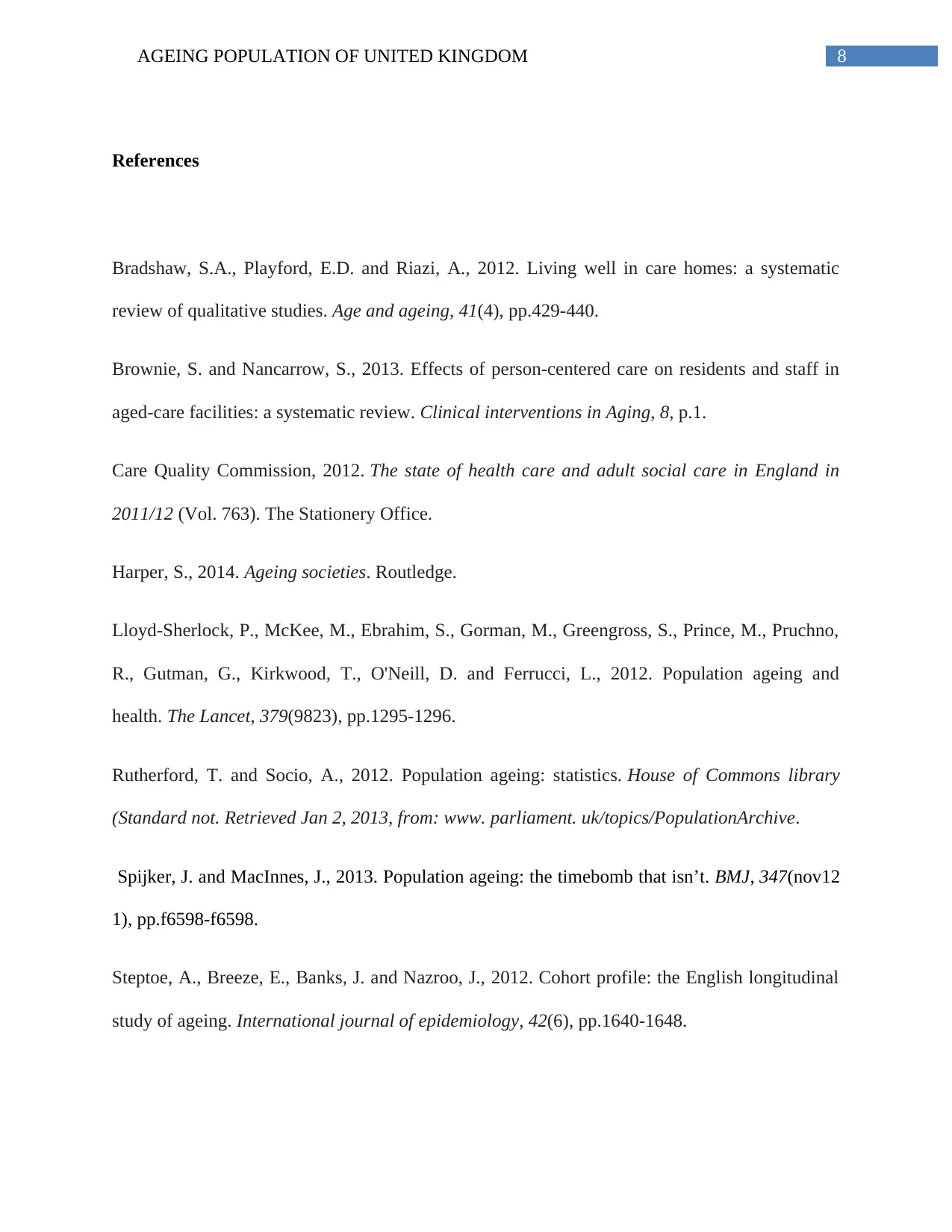
8AGEING POPULATION OF UNITED KINGDOM
References
Bradshaw, S.A., Playford, E.D. and Riazi, A., 2012. Living well in care homes: a systematic
review of qualitative studies. Age and ageing, 41(4), pp.429-440.
Brownie, S. and Nancarrow, S., 2013. Effects of person-centered care on residents and staff in
aged-care facilities: a systematic review. Clinical interventions in Aging, 8, p.1.
Care Quality Commission, 2012. The state of health care and adult social care in England in
2011/12 (Vol. 763). The Stationery Office.
Harper, S., 2014. Ageing societies. Routledge.
Lloyd-Sherlock, P., McKee, M., Ebrahim, S., Gorman, M., Greengross, S., Prince, M., Pruchno,
R., Gutman, G., Kirkwood, T., O'Neill, D. and Ferrucci, L., 2012. Population ageing and
health. The Lancet, 379(9823), pp.1295-1296.
Rutherford, T. and Socio, A., 2012. Population ageing: statistics. House of Commons library
(Standard not. Retrieved Jan 2, 2013, from: www. parliament. uk/topics/PopulationArchive.
Spijker, J. and MacInnes, J., 2013. Population ageing: the timebomb that isn’t. BMJ, 347(nov12
1), pp.f6598-f6598.
Steptoe, A., Breeze, E., Banks, J. and Nazroo, J., 2012. Cohort profile: the English longitudinal
study of ageing. International journal of epidemiology, 42(6), pp.1640-1648.
References
Bradshaw, S.A., Playford, E.D. and Riazi, A., 2012. Living well in care homes: a systematic
review of qualitative studies. Age and ageing, 41(4), pp.429-440.
Brownie, S. and Nancarrow, S., 2013. Effects of person-centered care on residents and staff in
aged-care facilities: a systematic review. Clinical interventions in Aging, 8, p.1.
Care Quality Commission, 2012. The state of health care and adult social care in England in
2011/12 (Vol. 763). The Stationery Office.
Harper, S., 2014. Ageing societies. Routledge.
Lloyd-Sherlock, P., McKee, M., Ebrahim, S., Gorman, M., Greengross, S., Prince, M., Pruchno,
R., Gutman, G., Kirkwood, T., O'Neill, D. and Ferrucci, L., 2012. Population ageing and
health. The Lancet, 379(9823), pp.1295-1296.
Rutherford, T. and Socio, A., 2012. Population ageing: statistics. House of Commons library
(Standard not. Retrieved Jan 2, 2013, from: www. parliament. uk/topics/PopulationArchive.
Spijker, J. and MacInnes, J., 2013. Population ageing: the timebomb that isn’t. BMJ, 347(nov12
1), pp.f6598-f6598.
Steptoe, A., Breeze, E., Banks, J. and Nazroo, J., 2012. Cohort profile: the English longitudinal
study of ageing. International journal of epidemiology, 42(6), pp.1640-1648.
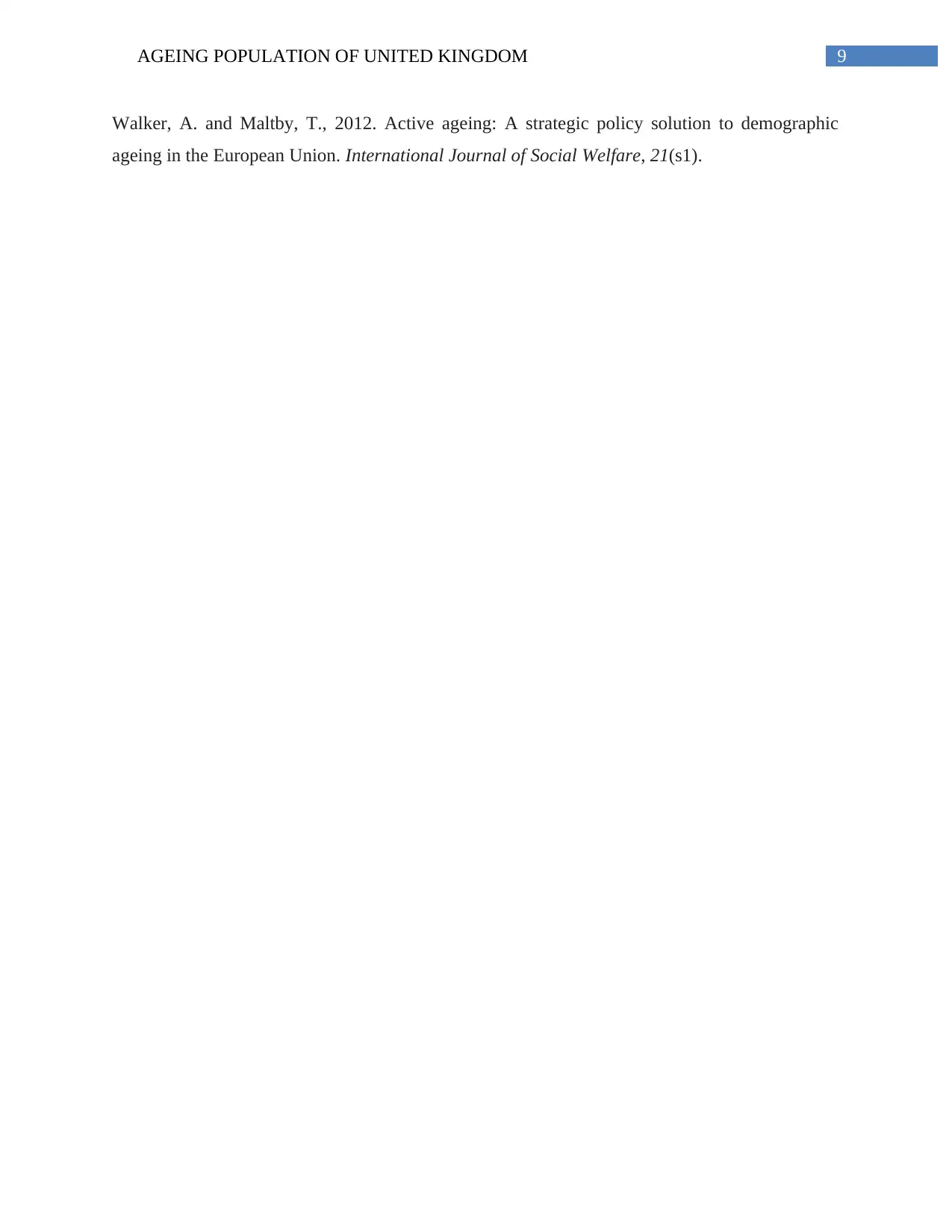
9AGEING POPULATION OF UNITED KINGDOM
Walker, A. and Maltby, T., 2012. Active ageing: A strategic policy solution to demographic
ageing in the European Union. International Journal of Social Welfare, 21(s1).
Walker, A. and Maltby, T., 2012. Active ageing: A strategic policy solution to demographic
ageing in the European Union. International Journal of Social Welfare, 21(s1).
1 out of 10
Related Documents
Your All-in-One AI-Powered Toolkit for Academic Success.
+13062052269
info@desklib.com
Available 24*7 on WhatsApp / Email
![[object Object]](/_next/static/media/star-bottom.7253800d.svg)
Unlock your academic potential
© 2024 | Zucol Services PVT LTD | All rights reserved.





